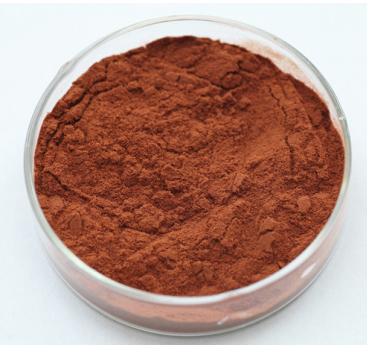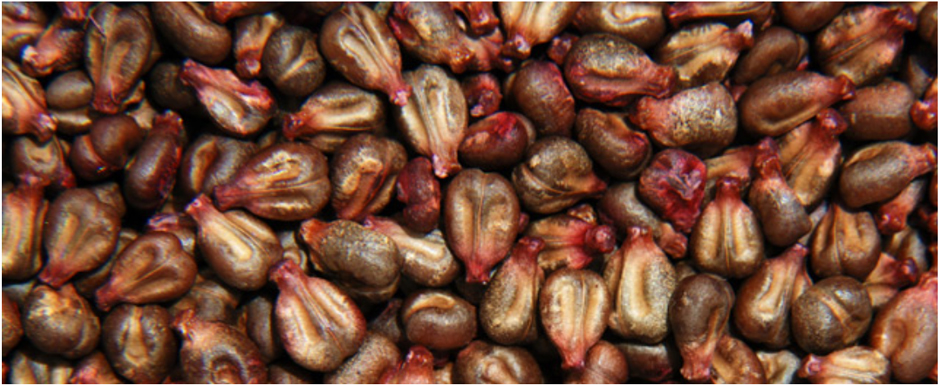2017 wholesale price Grape seed extract in Macedonia
2017 wholesale price Grape seed extract in Macedonia Detail:
[Latin Name] Vitis vinifera Linn
[Plant Source] Grape seed from Europe
[Specifications] 95%OPCs;45-90% polyphenols
[Appearance] Red brown powder
[Plant Part Used]: seed
[Particle size] 80 Mesh
[Loss on drying] ≤5.0%
[Heavy Metal] ≤10PPM
[Pesticide residue] EC396-2005, USP 34, EP 8.0, FDA
[Storage] Store in cool & dry area, keep away from the direct light and heat.
[Shelf life] 24 Months
[Package] Packed in paper-drums and two plastic-bags inside.
[Gerneral feature]
- Our product has passed the ID test by ChromaDex, Alkemist Lab. and other
third-party authoritative testing institutions, such as detection;
2. The pesticide residues match (EC) No 396/2005 USP34, EP8.0, FDA and other foreign pharmacopoeia standards and regulations;
3. The heavy metals in strict accordance with the foreign pharmacopoeia standard controls, such as USP34, EP8.0, FDA, etc.;
4. Our company set up a branch and import raw materials directly from Europe with strict control of heavy metal and pesticide residue. Aslo ensure the procyanidins content in grape seed is more than 8.0%.
5. OPCs over 95%, polyphenol over 70%, high activity, the oxidation resistance is strong, the ORAC more than 11000.
[Function]
Grapes (Vitis vinifera) have been heralded for their medicinal and nutritional value for thousands of years. Egyptians ate grapes a very long time back, and several ancient Greek philosophers spoke about the healing power of grapes — usually in the form of wine. European folk healers made an ointment from the sap of grapevines to treat skin and eye diseases. Grape leaves were used to stop bleeding, inflammation, and pain, such as the kind brought on by hemorrhoids. Unripe grapes were used to treat sore throats, and dried grapes (raisins) were used for constipation and thirst. Round, ripe, sweet grapes were used to treat a range of health problems including cancer, cholera, smallpox, nausea, eye infections, and skin, kidney, and liver diseases.
Grape seed extracts are industrial derivatives from whole grape seeds that have a great concentration of vitamin E, flavonoids, linoleic acid and phenolic OPCs. The typical commercial opportunity of extracting grape seed constituents has been for chemicals known as polyphenols having antioxidant activity in vitro.
Product detail pictures:

Related Product Guide:
Our company puts emphasis on the management, the introduction of talented personnel, and the construction of staff building, trying hard to improve the quality and liability consciousness of staff members. Our company successfully attained IS9001 Certification and European CE Certification of 2017 wholesale price Grape seed extract in Macedonia , The product will supply to all over the world, such as: Borussia Dortmund, Amsterdam, Czech, With a wide range, good quality, reasonable prices and stylish designs, our products are extensively used in public placesand other industries. Our products are widely recognized and trusted by users and can meet continuously developing economic and social needs. We welcome new and old customers from all walks of life to contact us for future business relationships and achieving mutual success!
How to make homemade hard-candy lollipops using a candy mold, a cornstarch mold and no mold at all ![]()
Candy Apple Chips Video:
2 cups white granulated sugar (200g)
2/3 cups corn syrup (160 ml)
1/4 cup water (60 ml)
flavouring (like almond, lemon, orange extracts) or candy oils. I used 1 tsp (5ml)
food colour if desired
Combine sugar, corn syrup, water, flavouring and food colouring in a large saucepan. Heat over high heat, stirring constantly until mixture starts to boil. After the mixture boils, stop stirring and reduce heat slightly keeping the mixture at a vigorous boil. You can use a pastry brush dipped in cold water to wipe down the sides of the saucepan to dissolve sugar crystals. This is supposed to help sudden crystallization of the sugar mixture, but this has never happened to me in all the years I have been making candy.
Cook the candy until it reaches a temperature of 310 F (154 C). If you are making free-form lollipops, place the hot saucepan into an ice bath to cool it down. Let sit about 20 seconds. Swirl pan 2 minutes more to cool.
Pour syrup into another container with a spout if desired. Working quickly, pour syrup onto baking sheets covered with silicone mat or parchment paper, forming circles and spacing circles about 3 inches apart. Press a lollipop stick into each circle. Add sprinkles to lollipops if desired, pressing them into the candy (carefully) with fingers or wooden skewer.
Molds I bought were found here:
https://www.goldaskitchen.com/merchant.ihtml?pid=5964&step=4
Here is an excellent tutorial on how to make many small candies using the cornstarch method.
https://www.instructables.com/id/Corn-Starch-Candy-Molds/?ALLSTEPS
Good visual/video description of the candy stages (you need hard-crack stage for this recipe)
https://www.exploratorium.edu/cooking/candy/sugar-stages.html
NOTES:
This candy will become sticky at room temperature very quickly especially in a humid room/climate. I find that if you put the in the refrigerator (not freezer) UNCOVERED they will stay dry.
I mention in the video that I added the colour at the beginning and that this was okay, after reading a little about this I have found the following on this website:
https://baking911.com/learn/baked-goods/candy/types/hard-candy
“And also (I could go on and on about colors) color should be added *late* in the cooking process, after the syrup reaches 275 degrees. The reason is that trace amounts of acid in food colors tend to “invert” the sucrose, a side-effect of which is to soften it, making the end result sticky. The longer the acid is in contact with the hot syrup, the more pronounced the inversion.”
I recommend adding the colour after the syrup reaches 275F and maybe that will help with the stickiness.
Corn starch molds:
Sifting the corn starch into the container may help achieving a smooth mold, also properly smoothing the top will help too.
Contact me here:
https://yoyomax12.weebly.com/contact-me.html
https://www.facebook.com/TammyYoyomax12?ref=hl
https://pinterest.com/yoyomax12
Google Plus:
https://tinyurl.com/kq7mwn6
My favourite channel here on YouTube is CookingAndCrafting. Beth lives in Hawaii and makes great meals, desserts and crafts. We met here on YouTube by commenting on each others videos and have since met each other several times in “real life”. She is a lovely person and a great friend. Please check her out ![]()
https://www.youtube.com/cookingandcrafting
Classic TV Commercials playlist: https://www.youtube.com/playlist?list=PL_hX5wLdhf_I3wE8to5xHS4P6v_2baOU3
Dristan nasal decongestant television commercial says “Dristan is like sending your sinuses to Arizona” which is enacted with a giant flying suitcase, which in fact carries one’s entire body to The Grand Canyon State.
Public domain film from the Library of Congress Prelinger Archives, slightly cropped to remove uneven edges, with the aspect ratio corrected, and one-pass brightness-contrast-color correction & mild video noise reduction applied.
The soundtrack was also processed with volume normalization, noise reduction, clipping reduction, and/or equalization (the resulting sound, though not perfect, is far less noisy than the original).
https://creativecommons.org/licenses/by-sa/3.0/
https://en.wikipedia.org/wiki/Decongestant
A decongestant (or nasal decongestant) is a type of pharmaceutical drug that is used to relieve nasal congestion in the upper respiratory tract. The active ingredient in most decongestants is either pseudoephedrine or phenylephrine (the latter of which has disputed efficacy).
These are alpha-agonists which on topical application as dilute solution (0.05-0.1%) produce local vasoconstriction. Regular use of these agents for long periods should be avoided because mucosal ciliary function is impaired: atrophic rhinitis and anosmia can occur due to persistent vasoconstriction.
Decongestants can be absorbed from the nose via an inhaler and produce systemic effects, mainly CNS stimulation and rise in blood pressure. These drugs should be used cautiously in hypertensives and in those receiving MAO inhibitors…
Pharmacology
The vast majority of decongestants act via enhancing norepinephrine (noradrenaline) and epinephrine (adrenaline) or adrenergic activity by stimulating the α-adrenergic receptors. This induces vasoconstriction of the blood vessels in the nose, throat, and paranasal sinuses, which results in reduced inflammation (swelling) and mucus formation in these areas.
Decongestant nasal sprays and eye drops often contain oxymetazoline and are used for topical decongestion. Pseudoephedrine acts indirectly on the adrenergic receptor system, whereas phenylephrine and oxymetazoline are direct agonists. The effects are not limited to the nose, and these medicines may cause hypertension (high blood pressure) through vasoconstriction. Most decongestants, however, are not pronounced stimulants, due to lack of response from the other adrenoreceptors. Besides hypertension, common side-effects include sleeplessness, anxiety, dizziness, excitability, and nervousness.
Topical nasal or ophthalmic decongestants quickly develop tachyphylaxis (a rapid decrease in the response to a drug after repeated doses over a short period of time). Long-term use is not recommended, since these agents lose effectiveness after a few days…
Lists
Common decongestants include:
- Ephedrine
- Levomethamphetamine
- Naphazoline
- Oxymetazoline
- Phenylephrine
- Phenylpropanolamine
- Propylhexedrine
- Synephrine
- Tetrahydrozoline
- Xylometazoline
- Pseudoephedrine—controlled in some jurisdictions for over the counter use
- Tramazoline
Uncommon or discontinued decongestants include:
- Cafaminol
- Cyclopentamine
- Epinephrine
- Fenoxazoline
- Levonordefrin
- Mephentermine
- Metizoline
- Norepinephrine
- Tuaminoheptane
- Tymazoline
The sales person is professional and responsible, warm and polite, we had a pleasant conversation and no language barriers on communication.







